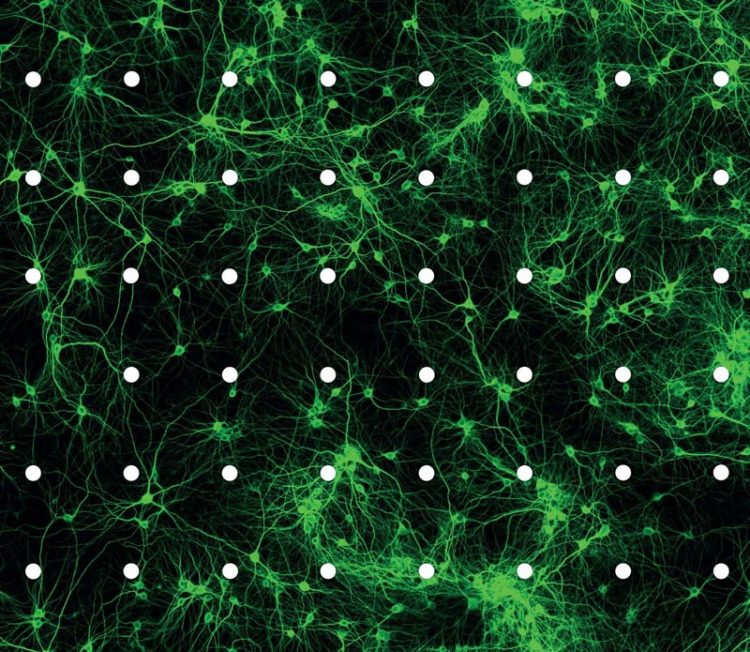Calcium channel subunits play a major role in autistic disorders

After 21 days in vitro, hippocampal neurons of the rat form many synaptic contacts and communicate with each other. Within the study such neuronal networks cultivated on multi-electrode arrays were used to invest the synaptogenic function of α2δ-subunits. ill./©: Artur Bikbaev
The ability of the human brain to process and store information is determined to a large extent by the connectivity between nerve cells. Chemical synapses are very important in this context as they constitute the interface for the transmission of information between individual nerve cells.
Abnormalities in the formation of synapses cause many neurological disorders such as autism. Neurobiologists at Johannes Gutenberg University Mainz (JGU) have found new evidence that specific calcium channel subunits play a crucial role in the development of excitatory and inhibitory synapses.
α2δ subunits have different effects on the formation of new synapses
Autism spectrum disorder is a condition involving impaired development that begins with birth and is usually manifested when the individual in question exhibits difficulties in social interaction and communication. It is postulated that the main underlying cause is disruption of synapse-mediated interaction between nerve cells.
The results of several studies indicate that so-called α2δ subunits of calcium channels are involved in the formation and fine-tuning of excitatory and inhibitory nerve cells, but little has been known to date about when and how specifically the four forms of α2δ subunits are involved.
It is this aspect that the research team led by Professor Martin Heine of the Institute of Developmental Biology and Neurobiology at Mainz University has now addressed. What is particularly interesting is their research finding that the two dominant α2δ subunits in the hippocampus, α2δ1 and α2δ3, have different effects on synaptogenesis in neuronal networks.
In order to investigate the underlying mechanism, the researchers prepared isolated networks of hippocampal neurons. The results show that during the early phase of the development of neural networks, subunit α2δ3 promotes the release of an inhibitory neurotransmitter, triggers the formation of inhibitory synapses, and boosts the growth of axons from inhibitory neurons.
“The α2δ3 subunit is obviously an important factor with regard to the early development of neural networks,” explained Heine. At later development phases and in more mature neuronal networks, it is subunit α2δ1 that fosters excitatory stimulus transmission and synaptogenesis.
Connectivity relies on concerted cooperation between α2δ1 and α2δ3
In their article in The Journal of Neuroscience, the researchers proposed “that formation of connectivity in neuronal networks is associated with a concerted interplay of α2δ1 and α2δ3 subunits of calcium channels”.
Dr. Artur Bikbaev, one of the lead authors from JGU, further concluded that the calcium channel subunits are molecules that are relevant to the development of the brain. New data has confirmed the assumption that there is a link between an aberration in the genes that code for subunits α2δ1 and α2δ3 and autistic spectrum disorders.
An imbalance in the ratio of excitatory to inhibitory neurons is also thought to be the cause of the epileptic seizures which very frequently accompany autism spectrum disorder.
In addition to the team at JGU, researchers at the Leibniz Institute for Neurobiology, the University of Münster, and the Medical University of Innsbruck were also involved in the project.
Image:
* http://download.uni-mainz.de/presse/10_idn_neurobio_kalziumkanal_untereinheiten….
After 21 days in vitro, hippocampal neurons of the rat form many synaptic contacts and communicate with each other. Within the study such neuronal networks cultivated on multi-electrode arrays were used to invest the synaptogenic function of α2δ-subunits.
ill./©: Artur Bikbaev
Related links:
* https://fnb-idn.biologie.uni-mainz.de/ – Functional Neurobiology group at the JGU Institute of Developmental Biology and Neurobiology (IDN)
Read more:
* https://www.uni-mainz.de/presse/aktuell/11315_ENG_HTML.php – press release “Nanodomains are involved in neuronal communication” (30 April 2020)
Contact:
Professor Dr. Martin Heine
Institute of Developmental Biology and Neurobiology (IDN)
Johannes Gutenberg University Mainz
55099 Mainz, GERMANY
phone +49 6131 39-26682
fax +49 6131 39-26804
e-mail: marthein@uni-mainz.de
https://idn.biologie.uni-mainz.de/prof-dr-martin-heine/
Media Contact
All latest news from the category: Life Sciences and Chemistry
Articles and reports from the Life Sciences and chemistry area deal with applied and basic research into modern biology, chemistry and human medicine.
Valuable information can be found on a range of life sciences fields including bacteriology, biochemistry, bionics, bioinformatics, biophysics, biotechnology, genetics, geobotany, human biology, marine biology, microbiology, molecular biology, cellular biology, zoology, bioinorganic chemistry, microchemistry and environmental chemistry.
Newest articles

Pinpointing hydrogen isotopes in titanium hydride nanofilms
Although it is the smallest and lightest atom, hydrogen can have a big impact by infiltrating other materials and affecting their properties, such as superconductivity and metal-insulator-transitions. Now, researchers from…

A new way of entangling light and sound
For a wide variety of emerging quantum technologies, such as secure quantum communications and quantum computing, quantum entanglement is a prerequisite. Scientists at the Max-Planck-Institute for the Science of Light…

Telescope for NASA’s Roman Mission complete, delivered to Goddard
NASA’s Nancy Grace Roman Space Telescope is one giant step closer to unlocking the mysteries of the universe. The mission has now received its final major delivery: the Optical Telescope…



